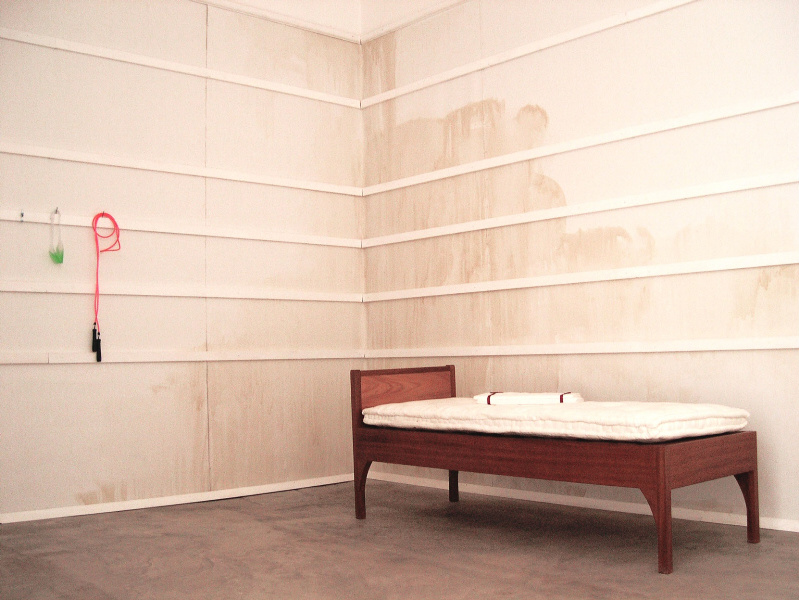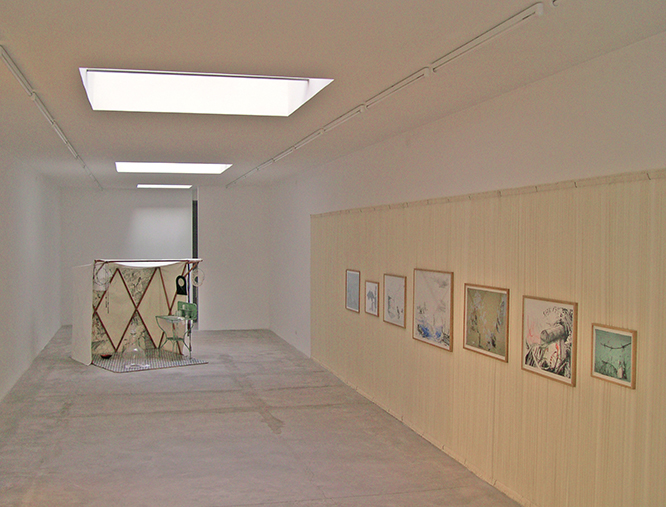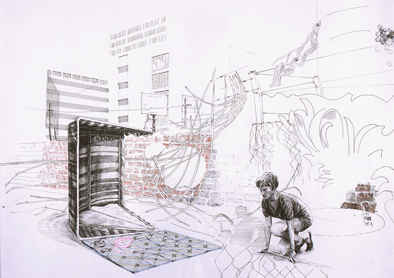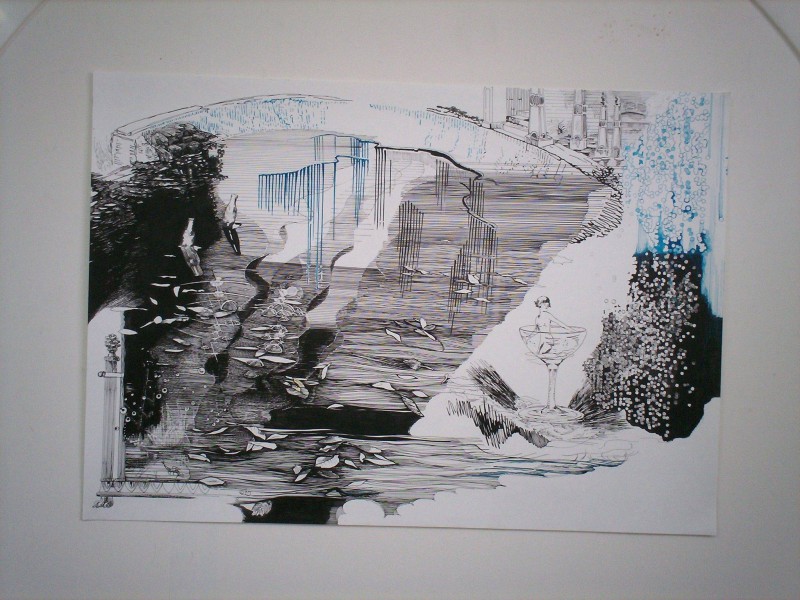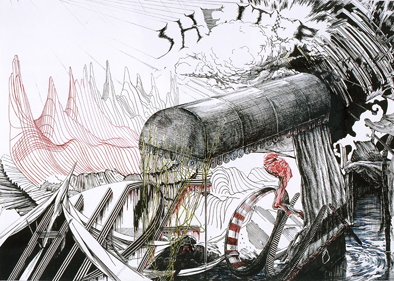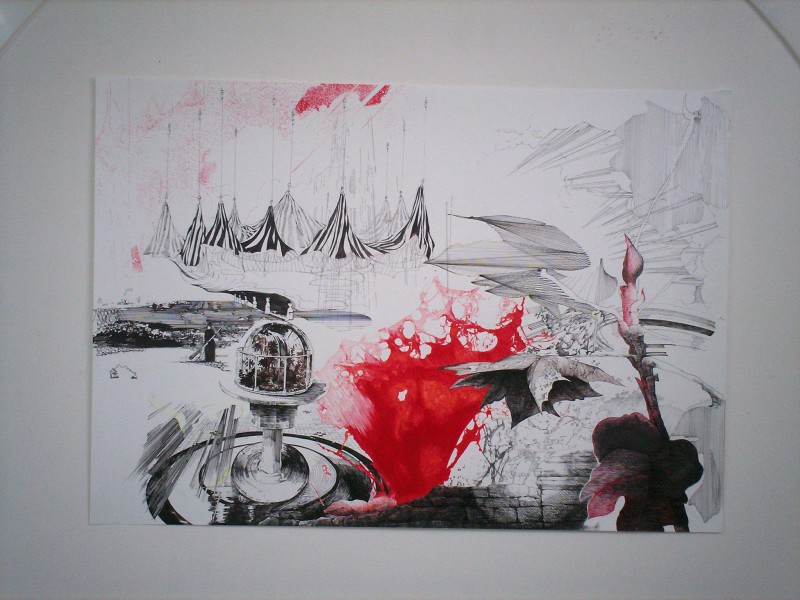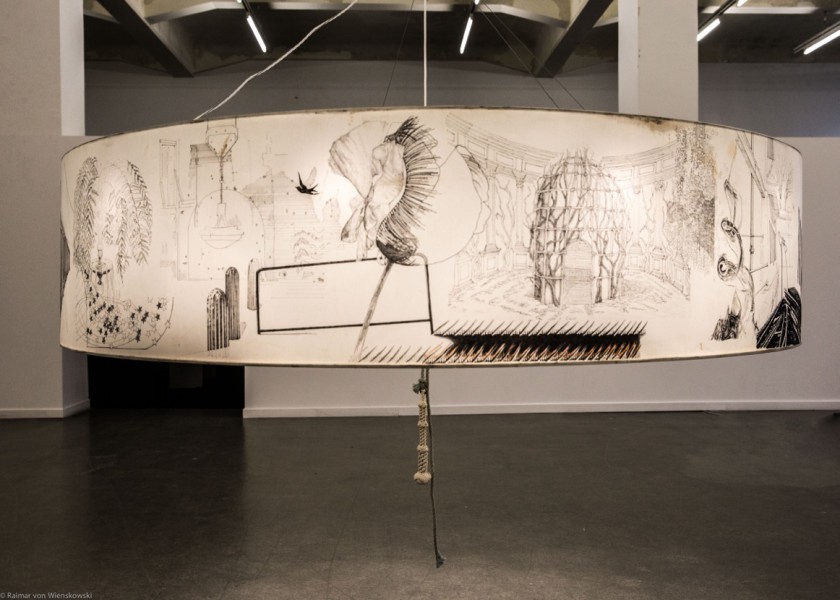Post
Kerstin Kartscher è nata a Norimberga nel 1966. dopo aver frequentato la Akademie für Bildende Künste nella sua città natale, si trasferisce e ha diverse esperienze di residenza dartista, tra cui il prestigioso Tate St Ives Artists’ Residency Programme (2004). Importanti istituzioni hanno esibito i suoi lavori: Migros Museum for Contemporary Art, Zurich (G, 2011, 2004 and 2002), Deichtorhallen Hamburg/Sammlung Falckenberg, Hamburg (G, 2011, 2006), MoMa, New York (G, 2009), Kunstmuseum Liechtenstein, Vaduz (G, 2009 and 2007), Kunstraum Deutsche Bank, Salisburgo (G, 2008), The Drawing Room, London (G, 2007), Tate St Ives, Cornwall (S, 2005), Kunsthalle Nüernberg (G, 2005, 1997), Grazer Kunstverein, Graz (G, 2004), Hamburger Kunsthalle, Hamburg (G, 2004), Kunstverein Hamburg (G, 1999, 1997), Sprengel Museum, Hannover (G, 1998). Attualmente lartista vive e lavora a Londra.
La pratica artistica di Kerstin Kartscher corre su un ideale continuum che unisce larte grafica e linstallazione; le sue opere sono disegni, lavori ambientali, ma anche sculture, spesso fatte alla foggia di oggetti darredamento. Nelle sue opere lartista racconta di altri mondi, dando una realizzazione estetica al desiderio profondo di crearsene uno proprio, nel quale rifugiarsi e nel quale chiunque possa sentirsi libero e intimamente al sicuro. I suoi paesaggi presentano mondi immaginari sconfinati, nei quali soffermarsi in un’attività contemplativa o nei quali lasciarsi andare e viaggiare. L’artista immagina di far entrare lo spettatore in un luogo sacro, in una realtà visionaria che scaturisce dalla miscela di stili artistici che entrano a far parte dell immaginario dellartista. Dame della Belle Epoque vengono ritratte su sfondi esotici, gli oggetti duso richiamano lepoca coloniale, gli ambienti creati dallartista sono rifugi in cui dettagli di una calda quotidianità si mescolano ad un gusto ornamentale che travalica epoche e confini geografici. Le opere di Kerstin Karscher delimitano sempre un dentro e un fuori, che si identificano come dimensioni fisiche nello spazio dellesibizione, e che identificano delle dimensioni psicologiche quali pericolo e protezione, rifiuto e accettazione, colpa e innocenza. Esse, presupponendo una realtà tesa tra forze opposte terribili e sfuggenti, aprono ad una riflessione anche politica sullintimo, sul femminile e sulla violenza, una riflessione che viene sempre e comunque ricondotta al sentimentale e al personale.
La pratica artistica di Kerstin Kartscher corre su un ideale continuum che unisce larte grafica e linstallazione; le sue opere sono disegni, lavori ambientali, ma anche sculture, spesso fatte alla foggia di oggetti darredamento. Nelle sue opere lartista racconta di altri mondi, dando una realizzazione estetica al desiderio profondo di crearsene uno proprio, nel quale rifugiarsi e nel quale chiunque possa sentirsi libero e intimamente al sicuro. I suoi paesaggi presentano mondi immaginari sconfinati, nei quali soffermarsi in un’attività contemplativa o nei quali lasciarsi andare e viaggiare. L’artista immagina di far entrare lo spettatore in un luogo sacro, in una realtà visionaria che scaturisce dalla miscela di stili artistici che entrano a far parte dell immaginario dellartista. Dame della Belle Epoque vengono ritratte su sfondi esotici, gli oggetti duso richiamano lepoca coloniale, gli ambienti creati dallartista sono rifugi in cui dettagli di una calda quotidianità si mescolano ad un gusto ornamentale che travalica epoche e confini geografici. Le opere di Kerstin Karscher delimitano sempre un dentro e un fuori, che si identificano come dimensioni fisiche nello spazio dellesibizione, e che identificano delle dimensioni psicologiche quali pericolo e protezione, rifiuto e accettazione, colpa e innocenza. Esse, presupponendo una realtà tesa tra forze opposte terribili e sfuggenti, aprono ad una riflessione anche politica sullintimo, sul femminile e sulla violenza, una riflessione che viene sempre e comunque ricondotta al sentimentale e al personale.
Kerstin Kartscher was born in Nürnberg in 1966. After having attended the Akademie für Bildende Künste in her home town, she moves away and has different experiences af artist residency, among which the prestigious Tate St Ives Artists’ Residency Programme (2004). Important institutions exhibited her works: Migros Museum for Contemporary Art, Zurich (G, 2011, 2004 and 2002), Deichtorhallen Hamburg/Sammlung Falckenberg, Hamburg (G, 2011, 2006), MoMa, New York (G, 2009), Kunstmuseum Liechtenstein, Vaduz (G, 2009 and 2007), Kunstraum Deutsche Bank, Salisburgo (G, 2008), The Drawing Room, London (G, 2007), Tate St Ives, Cornwall (S, 2005), Kunsthalle Nüernberg (G, 2005, 1997), Grazer Kunstverein, Graz (G, 2004), Hamburger Kunsthalle, Hamburg (G, 2004), Kunstverein Hamburg (G, 1999, 1997), Sprengel Museum, Hannover (G, 1998).
The artist currently livea and works in London.
The artistic practice of Kerstin Kartscher runs on in ideal continuum that binds graphic art to installation; her works are drawings, environmental works, but also scultptures, often executed as décor. In her works the artist tells of other worlds, giving aesthetic realization to the deep desire of creating her own one, as a shelter where anyone can feel safe and enjoy an intimate sense of freedom. Her landscapes show fictious territories where one can linger in contemplation or let go of boundaries. The artist desires for the spectator to enter in a sacred world, in a visionary reality, imbued of various artistic styles. Ladies of the Belle Époque are portrayed over exotic backgrouds, objects from everyday life recall the colonial era, the environments created by the artis are refugees where details of a warm routine are mixed together with an ornamental taste that crosses time and geographic borders. Kerstin Kartschers works always mark an inside off from an outside, that are identified as physical dimensions of the exhibition space and that identify psychological dimensions such as danger and protection, refusal and acceptance, guilt and innoncence. These ones, assuming a reality taut between opposite forces, shifty and dreadful at the same time, open up to a reflection a political, too on intimacy, on femininity, on violence, a reflection that is always reconducted to the realm of feelings and personal life.
The artist currently livea and works in London.
The artistic practice of Kerstin Kartscher runs on in ideal continuum that binds graphic art to installation; her works are drawings, environmental works, but also scultptures, often executed as décor. In her works the artist tells of other worlds, giving aesthetic realization to the deep desire of creating her own one, as a shelter where anyone can feel safe and enjoy an intimate sense of freedom. Her landscapes show fictious territories where one can linger in contemplation or let go of boundaries. The artist desires for the spectator to enter in a sacred world, in a visionary reality, imbued of various artistic styles. Ladies of the Belle Époque are portrayed over exotic backgrouds, objects from everyday life recall the colonial era, the environments created by the artis are refugees where details of a warm routine are mixed together with an ornamental taste that crosses time and geographic borders. Kerstin Kartschers works always mark an inside off from an outside, that are identified as physical dimensions of the exhibition space and that identify psychological dimensions such as danger and protection, refusal and acceptance, guilt and innoncence. These ones, assuming a reality taut between opposite forces, shifty and dreadful at the same time, open up to a reflection a political, too on intimacy, on femininity, on violence, a reflection that is always reconducted to the realm of feelings and personal life.
